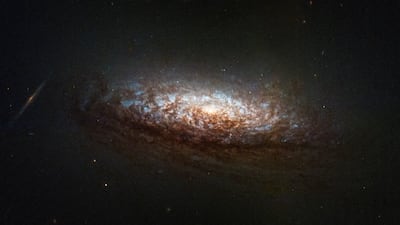The Hubble Space Telescope has resumed scientific operations and captured a detailed image of a distant galaxy, after weeks of inactivity due to technical issues.
This follows a transition to a new operational mode relying on a single gyroscope – a critical instrument for controlling and orienting the telescope.
The ageing observatory, which was launched in 1990, entered safe mode on May 24 because of a malfunctioning gyro that prevented its operations.
We’re poised now for many years of discovery ahead
Dr Jennifer Wiseman,
senior project scientist for Hubble
When built, it was fitted with six gyros, but only three remain active. Nasa decided a few weeks ago to save two for future use and utilise just one to resume operations.
“Hubble’s new image of a spectacular galaxy demonstrates the full success of our new, more stable pointing mode for the telescope,” said Dr Jennifer Wiseman, senior project scientist for Hubble at Nasa.
“We’re poised now for many years of discovery ahead, and we’ll be looking at everything from our Solar System to exoplanets to distant galaxies.”
The new image features galaxy NGC 1546, which is located in the constellation Dorado, 169 light years away from Earth.
It shows the galaxy's dust lanes, which are backlit by its core, as well as several background galaxies, including a spiral one positioned to the left of NGC 1546.
Even though Nasa has figured out a way to extend Hubble's operations, there are now minor limitations on the telescope's data-gathering abilities, due to the decision to use only one gyro.
These include needing more time to turn and lock on to a target, meaning it will not have as much flexibility as to where it can observe at any given time.
The telescope will also not be able to track moving objects closer than Mars, though Nasa said that these are rare occurrences anyway.
Hubble, which has cost Nasa more than $16 billion so far, has been observing the universe for more than three decades – long exceeding its original expected mission lifespan of 15 years.
Despite its ageing hardware, Hubble continues to deliver groundbreaking scientific findings. These include data helping scientists to measure the universe’s expansion rate, detailed images of nebulas – also known as star nurseries – and uncovering the presence of water vapour in the atmospheres of planets outside our Solar System.
Over the years, it has faced multiple technical issues requiring numerous repairs and upgrades, including five servicing missions by space shuttle crews.
The James Webb Space Telescope, a $10 billion observatory, was launched in 2021 and is 100 times more powerful than Hubble.
It operates primarily in the infrared spectrum, allowing it to peer through cosmic dust and observe the universe's earliest galaxies and star formations.
The “time travel machine” has already made significant discoveries, including observations of the Cartwheel Galaxy, detecting water in the atmosphere of the exoplanet WASP-96b and capturing the most detailed images of the Southern Ring Nebula.
Abandon
Sangeeta Bandyopadhyay
Translated by Arunava Sinha
Tilted Axis Press
Classification of skills
A worker is categorised as skilled by the MOHRE based on nine levels given in the International Standard Classification of Occupations (ISCO) issued by the International Labour Organisation.
A skilled worker would be someone at a professional level (levels 1 – 5) which includes managers, professionals, technicians and associate professionals, clerical support workers, and service and sales workers.
The worker must also have an attested educational certificate higher than secondary or an equivalent certification, and earn a monthly salary of at least Dh4,000.
Small%20Things%20Like%20These
%3Cp%3EDirector%3A%20Tim%20Mielants%3Cbr%3ECast%3A%20Cillian%20Murphy%2C%20Emily%20Watson%2C%20Eileen%20Walsh%3Cbr%3ERating%3A%204%2F5%3C%2Fp%3E%0A
Company%20profile
%3Cp%3E%3Cstrong%3EName%3A%3C%2Fstrong%3E%20JustClean%3Cbr%3E%3Cbr%3E%3Cstrong%3EBased%3A%20%3C%2Fstrong%3EDubai%20with%20offices%20in%20other%20GCC%20countries%3Cbr%3E%3Cbr%3E%3Cstrong%3ELaunch%20year%3A%3C%2Fstrong%3E%202016%3Cbr%3E%3Cbr%3E%3Cstrong%3ENumber%20of%20employees%3A%3C%2Fstrong%3E%20160%2B%20with%2021%20nationalities%20in%20eight%20cities%3Cbr%3E%3Cstrong%3E%3Cbr%3ESector%3A%3C%2Fstrong%3E%20online%20laundry%20and%20cleaning%20services%3Cbr%3E%3Cbr%3E%3Cstrong%3EFunding%3A%20%3C%2Fstrong%3E%2430m%20from%20Kuwait-based%20Faith%20Capital%20Holding%20and%20Gulf%20Investment%20Corporation%3C%2Fp%3E%0A
hall of shame
SUNDERLAND 2002-03
No one has ended a Premier League season quite like Sunderland. They lost each of their final 15 games, taking no points after January. They ended up with 19 in total, sacking managers Peter Reid and Howard Wilkinson and losing 3-1 to Charlton when they scored three own goals in eight minutes.
SUNDERLAND 2005-06
Until Derby came along, Sunderland’s total of 15 points was the Premier League’s record low. They made it until May and their final home game before winning at the Stadium of Light while they lost a joint record 29 of their 38 league games.
HUDDERSFIELD 2018-19
Joined Derby as the only team to be relegated in March. No striker scored until January, while only two players got more assists than goalkeeper Jonas Lossl. The mid-season appointment Jan Siewert was to end his time as Huddersfield manager with a 5.3 per cent win rate.
ASTON VILLA 2015-16
Perhaps the most inexplicably bad season, considering they signed Idrissa Gueye and Adama Traore and still only got 17 points. Villa won their first league game, but none of the next 19. They ended an abominable campaign by taking one point from the last 39 available.
FULHAM 2018-19
Terrible in different ways. Fulham’s total of 26 points is not among the lowest ever but they contrived to get relegated after spending over £100 million (Dh457m) in the transfer market. Much of it went on defenders but they only kept two clean sheets in their first 33 games.
LA LIGA: Sporting Gijon, 13 points in 1997-98.
BUNDESLIGA: Tasmania Berlin, 10 points in 1965-66



